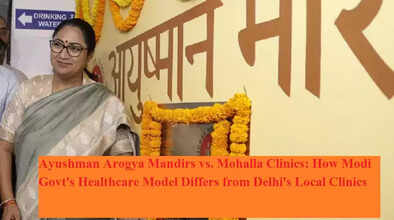Ayushman Arogya Mandirs vs. Mohalla Clinics: How Modi Govt's Healthcare Model Differs from Delhi's Local Clinics

In a major healthcare shift in Delhi, the central government has launched 33 new Ayushman Arogya Mandirs, gradually replacing the well-known Mohalla Clinics started by the Aam Aadmi Party (AAP). While both initiatives aim to provide free or affordable medical services to the public, they differ significantly in scope, accessibility, services offered, and funding.
Let’s take a closer look at how the two models compare — and why the introduction of Ayushman Arogya Mandirs may signal a transformation in primary healthcare delivery across the city and beyond.
What Are Ayushman Arogya Mandirs?
Ayushman Arogya Mandirs are part of the Ayushman Bharat – Pradhan Mantri Jan Arogya Yojana (PM-JAY) launched by the central government. These centers focus on providing comprehensive primary healthcare services, especially to economically weaker sections. Designed to bridge the healthcare gap in both rural and urban regions, these facilities offer much more than just treatment for common illnesses.
According to the Ministry of Health and Family Welfare, over 1.77 lakh Ayushman Arogya Mandirs have been established across India. In Delhi alone, 33 such centers were inaugurated recently, including one in Tis Hazari, by Chief Minister Rekha Gupta. These centers are part of a broader effort to strengthen grassroots healthcare infrastructure with modern amenities.
Through my lens---Medicines, path tests, yoga! All for free at revamped centres. #ayushmanarogyamandir @CMODelhi delhi govt is launching 33 of these facilities today. pic.twitter.com/8FQabL2dL1
— Anindya Chattopadhyay (@ANINDYAtimes) June 17, 2025
Key Features of Ayushman Arogya Mandirs
Unlike Mohalla Clinics, these new healthcare facilities offer a much wider array of services, including:
-
Free OPD services
-
Maternal and child health care, including prenatal and postnatal support
-
Family planning and reproductive health services
-
Screening and management of non-communicable diseases like diabetes, hypertension, and cancer
-
Treatment for infectious diseases such as tuberculosis and leprosy
-
14 in-house diagnostic tests and access to 79 advanced tests like LFT, KFT, and lipid profiles free of charge through partner labs
-
Yoga classes twice a week (Monday & Thursday)
-
Child immunization programs
These facilities are set up by upgrading existing Sub-Health Centres (SHCs) and Primary Health Centres (PHCs), with funding from the National Health Mission (NHM). This makes them more sustainable and consistent with national healthcare objectives.
How Are Mohalla Clinics Different?
The Mohalla Clinic model was introduced by the Aam Aadmi Party in 2015 with the goal of offering free basic medical care to urban residents, especially those in low-income neighborhoods and slum areas.
Here’s what makes Mohalla Clinics distinct:
-
Primarily cater to common ailments like colds, coughs, fever, minor wounds, and basic infections
-
Offer free medicines and basic diagnostic tests
-
Usually located in portable or rented spaces within densely populated residential areas
-
Serve roughly 10,000 to 15,000 people per clinic
-
Targeted mostly at the urban poor in Delhi and Punjab
-
Fully funded and managed by the Delhi state government
While highly accessible and popular for minor illnesses, Mohalla Clinics lack facilities for advanced testing, chronic disease management, or maternal health services — areas where Ayushman Arogya Mandirs step in to fill the gap.
A Side-by-Side Comparison
| Feature | Ayushman Arogya Mandir | Mohalla Clinic |
|---|---|---|
| Initiative By | Central Government | Delhi Government |
| Coverage | Nationwide | Limited to Delhi & Punjab |
| Services | Comprehensive care (including chronic disease management, pregnancy care, mental health, diagnostics, yoga) | Basic healthcare for common ailments |
| Infrastructure | Upgraded PHCs/SHCs | Portable or small rented clinics |
| Funding | National Health Mission | State-funded |
| Target Area | Urban and rural | Primarily urban and slum areas |
Why the Shift Matters
The replacement of Mohalla Clinics with Ayushman Arogya Mandirs in Delhi marks not just a change in infrastructure but also an expansion in the depth of services provided. It reflects the government’s push to standardize primary healthcare across India, ensuring that citizens in both cities and villages get access to similar facilities and benefits.
Moreover, integrating Ayushman Arogya Mandirs with Ayushman Bharat health cards creates a more seamless healthcare ecosystem — from primary care at the mandir level to hospitalization coverage under PM-JAY.
Final Thoughts
While Mohalla Clinics played a crucial role in revolutionizing urban healthcare access, especially for Delhi’s underprivileged communities, Ayushman Arogya Mandirs offer a more structured, expansive, and future-ready model. Whether this new system will completely replace the older one remains to be seen, but it certainly points toward a more integrated and nationalized approach to public health.
As both political and public interest in healthcare reform grows, the success of Ayushman Arogya Mandirs could become a blueprint for the next phase of India’s primary healthcare evolution.

